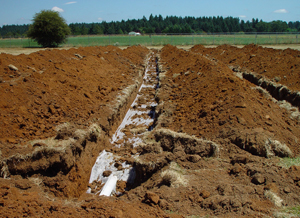Septic system basics
A septic system is the most common method of sewage treatment for homes and businesses that are not connected to an area wide sewage system. In its basic form, a septic system consists of a septic tank, where solids settle and decompose, and a drainfield where liquid discharged from the tank is treated by bacteria in the soil. More complex septic systems are installed in areas with high groundwater and/or poor soils. Examples include sand filter or alternative treatment technology systems which treat the wastewater to a higher degree prior to discharge to a drainfield.
Properly functioning septic systems treat sewage to minimize groundwater and surface water pollution. A malfunctioning system is a health hazard to your family and your neighbors, and will harm natural resources. Read more about how septic systems work.
Before you buy

If the property is undeveloped, ask if the property has been evaluated for suitability by either DEQ or a local government contract agent and if so, ask for the site evaluation report. Questions you need to ask:
Has the site changed since it was evaluated?
- Some changes that affect suitability include well construction, fill, driveways, etc.
- Considering the type of system listed as acceptable on the report and the approved location of the septic system, does the property meet your development needs?
If the property hasn't been evaluated, you may want the current owner to have a site evaluation completed. Application for a site evaluation is through either DEQ or a local government contract agent. Before agreeing to purchase the property you need to know what type of septic system will be required and that the approved system location will meet your development needs.
Existing septic systems - Prior to purchasing property with an existing septic system, you should hire a qualified inspector to check out the system. Here's what you need to find out:
-
Was the system installed with a permit? If not, it may be a very old system (permits have been required since 1972, and in some counties earlier), or illegally constructed. Illegally constructed systems may cause a public health hazard or create pollution. You may be required to upgrade or replace the system in the future and you could be liable and fined if the system fails or causes a threat to public health.
-
Is the system the proper size to accommodate the needs of your family or business? Permit records usually indicate the size of the system in gallons per day. For example, a four-bedroom home is sized at 450 gallon per day.
- How old is the system and has it been properly maintained? Are there records to show the septic tank was pumped on a regular basis?
-
Have there been any reported problems or complaints in the past? Your local permitting office may have records of complaints or violations that haven't yet been addressed. How many people previously lived in the house? Maybe the system works great with one person, not so great with four people. Are all plumbing fixtures connected to the septic tank?
-
Are there signs of septic system failure such as soggy areas over the septic tank or drainfield areas? Make sure there are no direct discharges if the property is adjacent to surface waters.
-
Is there a suitable area for a replacement septic system should the current system fail? Septic permit records, if any, indicate the replacement area that should still be 'set aside' for that purpose.
-
Who is a qualified inspector? Some septic installers and pumpers have been trained in inspecting existing systems, while some only install new septic systems or pump tanks, respectively. Certified maintenance providers may be a qualified inspector, too. The key is to ask what their qualifications are in septic system evaluations (not just the septic tank), and ask for some references. Check on those references before you hire a contractor.